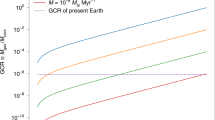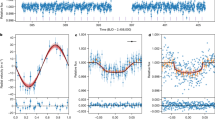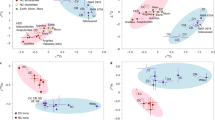Abstract
Mass-independent isotopic anomalies define two cosmochemically distinct regions: the carbonaceous and non-carbonaceous meteorites1, implying that the non-carbonaceous (terrestrial) and carbonaceous (Jovian) reservoirs were kept separate during and after planet formation. The formation of Jupiter is widely invoked to explain this compositional dichotomy by acting as an effective barrier between the two reservoirs2. Jupiter’s solid kernel possibly grew to 20 Earth masses (\({M}_{\oplus }\)) in 1 Myr from the accretion of submetre-sized objects (‘pebbles’), followed by slower accretion via planetesimals. Subsequent gas envelope contraction led to Jupiter’s formation as a gas giant3. Here, we use dynamical simulations to show that the growth of Jupiter from pebble accretion is not fast enough to be responsible for the inferred separation of the terrestrial and Jovian reservoirs. We propose instead that the dichotomy was caused by a pressure maximum in the disk near Jupiter’s location, which created a ringed structure such as those detected by ALMA4. One or multiple such—potentially mobile—long-lived pressure maxima almost completely prevented pebbles from the Jovian region reaching the terrestrial zone, maintaining a compositional partition between the two regions. We thus suggest that our young Solar System’s protoplanetary disk developed at least one and probably multiple rings, which potentially triggered the formation of the giant planets.
This is a preview of subscription content, access via your institution
Access options
Access Nature and 54 other Nature Portfolio journals
Get Nature+, our best-value online-access subscription
$29.99 / 30 days
cancel any time
Subscribe to this journal
Receive 12 digital issues and online access to articles
$119.00 per year
only $9.92 per issue
Buy this article
- Purchase on Springer Link
- Instant access to full article PDF
Prices may be subject to local taxes which are calculated during checkout




Similar content being viewed by others
Data availability
The data that support the plots within this paper and other findings of this study are available from the corresponding authors on reasonable request.
Code availability
The source codes and simulation output for the model used in this study are archived at the Earth Life Science Institute of the Tokyo Institute of Technology and are available on request from the corresponding authors. The SyMBA code that our simulations are based on is not in the public domain. It can be requested from its main author H. F. Levison at the Southwest Research Institute.
References
Warren, P. H. Stable-isotopic anomalies and the accretionary assemblage of the Earth and Mars: a subordinate role for carbonaceous chondrites. Earth Planet. Sci. Lett. 311, 93–100 (2011).
Kruijer, T. S., Burkhardt, C., Budde, G. & Kleine, T. Age of Jupiter inferred from the distinct genetics and formation times of meteorites. Proc. Natl Acad. Sci. 114, 6712–6716 (2017).
Alibert, Y. et al. The formation of Jupiter by hybrid pebble–planetesimal accretion. Nat. Astron. 2, 873–877 (2018).
Huang, J. et al. The Disk Substructures at High Angular Resolution Project (DSHARP). III. Spiral structures in the millimeter continuum of the Elias 27, IM Lup, and WaOph 6 disks. Astrophys. J. 869, L43 (2018).
Lambrechts, M. & Johansen, A. Rapid growth of gas-giant cores by pebble accretion. Astron. Astrophys. 544, A32 (2012).
Lambrechts, M., Johansen, A. & Morbidelli, A. Separating gas-giant and ice-giant planets by halting pebble accretion. Astron. Astrophys. 572, A35 (2014).
Ida, S., Guillot, T. & Morbidelli, A. The radial dependence of pebble accretion rates: a source of diversity in planetary systems. I. Analytical formulation. Astron. Astrophys. 591, A72 (2016).
Ormel, C. W. & Liu, B. Catching drifting pebbles. II. A stochastic equation of motion for pebbles. Astron. Astrophys. 615, A178 (2018).
Sato, T., Okuzumi, S. & Ida, S. On the water delivery to terrestrial embryos by ice pebble accretion. Astron. Astrophys. 589, A15 (2016).
Morbidelli, A. et al. Fossilized condensation lines in the Solar System protoplanetary disk. Icarus 267, 368–376 (2016).
Duncan, M. J., Levison, H. F. & Lee, M. H. A multiple time step symplectic algorithm for integrating close encounters. Astron. J. 116, 2067–2077 (1998).
Matsumura, S., Brasser, R. & Ida, S. N-body simulations of planet formation via pebble accretion. I. First results. Astron. Astrophys. 607, A67 (2017).
Wang, H. et al. Lifetime of the solar nebula constrained by meteorite paleomagnetism. Science 355, 623–627 (2017).
Johansen, A., Ida, S. & Brasser, R. How planetary growth outperforms migration. Astron. Astrophys. 622, A202 (2019).
Woo, J. M. Y., Brasser, R., Matsumura, S., Mojzsis, S. J. & Ida, S. The curious case of Mars’ formation. Astron. Astrophys. 617, A17 (2018).
Levison, H. F., Kretke, K. A., Walsh, K. J. & Bottke, W. F. Growing the terrestrial planets from the gradual accumulation of submeter-sized objects. Proc. Natl Acad. Sci. 112, 14180–14185 (2015).
Marty, B. The origins and concentrations of water, carbon, nitrogen and noble gases on Earth. Earth Planet. Sci. Lett. 313, 56–66 (2012).
Dauphas, N. The isotopic nature of the Earth’s accreting material through time. Nature 541, 521–524 (2017).
Kretke, K. A. & Lin, D. N. C. Grain retention and formation of planetesimals near the snow line in MRI-driven turbulent protoplanetary disks. Astrophys. J. 664, L55–L58 (2007).
Vorobyov, E. I., Akimkin, V., Stoyanovskaya, O., Pavlyuchenkov, Y. & Liu, H. B. Early evolution of viscous and self-gravitating circumstellar disks with a dust component. Astron. Astrophys. 614, A98 (2018).
van der Marel, N., Williams, J. P. & Bruderer, S. Rings and gaps in protoplanetary disks: planets or snowlines? Astrophys. J. 867, L14 (2018).
Pinilla, P. et al. Trapping dust particles in the outer regions of protoplanetary disks. Astron. Astrophys. 538, A114 (2012).
van der Marel, N. et al. A concentration of centimeter-sized grains in the Ophiuchus IRS 48 dust trap. Astrophys. J. 810, L7 (2015).
Pinilla, P., Flock, M., Ovelar, M. & Birnstiel, T. Can dead zones create structures like a transition disk? Astron. Astrophys. 596, A81 (2016).
Desch, S. J., Kalyaan, A. & Alexander, C. M. O’D. The effect of Jupiter’s formation on the distribution of refractory elements and inclusions in meteorites. Astrophys. J. Suppl. 238, A11 (2018).
Andrews, S. M. et al. Ringed substructure and a gap at 1 au in the nearest protoplanetary disk. Astrophys. J. 820, L40 (2016).
Long, F. et al. Gaps and rings in an ALMA survey of disks in the Taurus star-forming region. Astrophys. J. 869, A17 (2018).
Morbidelli, A., Tsiganis, K., Crida, A., Levison, H. F. & Gomes, R. Dynamics of the giant planets of the Solar System in the gaseous protoplanetary disk and their relationship to the current orbital architecture. Astron. J. 134, 1790–1798 (2007).
Kanagawa, K. D. et al. Impacts of dust feedback on a dust ring induced by a planet in a protoplanetary disk. Astrophys. J. 868, A48 (2018).
Levison, H. F., Kretke, K. A. & Duncan, M. J. Growing the gas-giant planets by the gradual accumulation of pebbles. Nature 524, 322–324 (2015).
Shakura, N. I. & Sunyaev, R. A. Black holes in binary systems. Observational appearance. Astron. Astrophys. 24, 337–355 (1973).
Hartmann, L., Calvet, N., Gullbring, E. & D’Alessio, P. Accretion and the evolution of T Tauri disks. Astrophys. J. 495, 385–400 (1998).
Garaud, P. & Lin, D. N. C. The effect of internal dissipation and surface irradiation on the structure of disks and the location of the snow line around Sun-like stars. Astrophys. J. 654, 606–624 (2007).
Ormel, C. W. & Klahr, H. H. The effect of gas drag on the growth of protoplanets. Analytical expressions for the accretion of small bodies in laminar disks. Astron. Astrophys. 520, A43 (2010).
Ikoma, M., Nakazawa, K. & Emori, H. Formation of giant planets: dependences on core accretion rate and grain opacity. Astrophys. J. 537, 1013–1025 (2000).
Ida, S., Lin, D. N. C. & Nagasawa, M. Toward a deterministic model of planetary formation. VII. Eccentricity distribution of gas giants. Astrophys. J. 775, 42 (2013).
Tanaka, H., Takeuchi, T. & Ward, W. R. Three-dimensional interaction between a planet and an isothermal gaseous disk. I. Corotation and Lindblad torques and planet migration. Astrophys. J. 565, 1257–1274 (2008).
Lin, D. N. C. & Papaloizou, J. C. B. On the tidal interaction between protoplanets and the protoplanetary disk. III. Orbital migration of protoplanets. Astrophys. J. 309, 846–857 (1986).
Coleman, G. A. L. & Nelson, R. P. On the formation of planetary systems via oligarchic growth in thermally evolving viscous discs. Mon. Not. R. Astron. Soc. 445, 479–499 (2014).
Paardekooper, S.-J., Baruteau, C. & Kley, W. A torque formula for non-isothermal type I planetary migration. II. Effects of diffusion. Mon. Not. R. Astron. Soc. 410, 293–303 (2011).
Fendyke, S. M. & Nelson, R. P. On the corotation torque for low-mass eccentric planets. Mon. Not. R. Astron. Soc. 437, 96–107 (2014).
Cresswell, P. & Nelson, R. P. Three-dimensional simulations of multiple protoplanets embedded in a protostellar disc. Astron. Astrophys. 482, 677–690 (2008).
Tanaka, H. & Ward, W. R. Three-dimensional interaction between a planet and an isothermal gaseous disk. II. Eccentricity waves and bending waves. Astrophys. J. 602, 388–395 (2004).
Wisdom, J. & Holman, M. Symplectic maps for the N-body problem. Astron. J. 102, 1528–1538 (1991).
Kinoshita, H., Yoshida, H. & Nakai, H. Symplectic integrators and their application to dynamical astronomy. Celest. Mech. Dyn. Astron. 50, 59–71 (1991).
Seager, S., Kuchner, M., Hier-Majumder, C. A. & Militzer, B. Mass–radius relationships for solid exoplanets. Astrophys. J. 669, 1279–1297 (2007).
Lissauer, J. J. et al. Architecture and dynamics of Kepler’s candidate multiple transiting planet systems. Astrophys. J. Suppl. 197, A8 (2011).
Clayton, R. N. & Mayeda, T. K. Oxygen isotopes in eucrites, shergottites, nakhlites, and chassignites. Earth Planet. Sci. Lett. 62, 1–6 (1983).
Clayton, R. N. & Mayeda, T. K. Oxygen isotope studies of achondrites. Geochim. Cosmochim. Acta 60, 1999–2017 (1996).
Franchi, I. A., Wright, I. P., Sexton, A. S. & Pillinger, C. T. The oxygen-isotopic composition of Earth and Mars. Meteorit. Planet. Sci. 34, 657–661 (1999).
Rubin, A. E. et al. Los Angeles: the most differentiated basaltic Martian meteorite. Geology 28, 1011–1014 (2000).
Mittlefehldt, D. W., Clayton, R. N., Drake, M. J. & Righter, K. Oxygen isotopic composition and chemical correlations in meteorites and the terrestrial planets. Rev. Mineral. Geochem. 68, 399–428 (2008).
Agee, C. B. et al. Unique meteorite from early Amazonian Mars: water-rich basaltic breccia Northwest Africa 7034. Science 339, 780–785 (2013).
Wittmann, A. et al. Petrography and composition of Martian regolith breccia meteorite Northwest Africa 7475. Meteorit. Planet. Sci. 50, 326–352 (2015).
Trinquier, A., Birck, J.-L. & Allegre, C. J. Widespread 54Cr heterogeneity in the inner Solar System. Astrophys. J. 655, 1179–1185 (2007).
Trinquier, A., Birck, J.-L., Allegre, C. J., Göpel, C. & Ulfbeck, D. 53Mn-53Cr systematics of the early Solar System revisited. Geochim. Cosmochim. Acta 72, 5146–5163 (2008).
Qin, L., Alexander, C. M. O’D., Carlson, R. W., Horan, M. F. & Yokoyama, T. Contributors to chromium isotope variation of meteorites. Geochim. Cosmochim. Acta 74, 1122–1145 (2010).
Petitat, M., Birck, J.-L., Luu, T. H. & Gounelle, M. The chromium isotopic composition of the ungrouped carbonaceous chondrite Tagish Lake. Astrophys. J. 736, 23–31 (2011).
Yamakawa, A. & Yin, Q.-Z. Chromium isotopic systematics of the Sutter’s Mill carbonaceous chondrite: implications for isotopic heterogeneities of the early Solar System. Meteorit. Planet. Sci. 49, 2118–2127 (2014).
Shukolyukov, A. & Lugmair, G. W. Manganese-chromium isotope systematics of carbonaceous chondrites. Earth Planet. Sci. Lett. 250, 200–213 (2006).
Yamashita, K., Maruyama, S., Yamakawa, A. & Nakamura, E. 53Mn-53Cr chronometry of CB chondrites: evidence for uniform distribution of 53Mn in the early Solar System. Astrophys. J. 728, A165 (2010).
Larsen, K. K. et al. Evidence for magnesium isotope heterogeneity in the solar protoplanetary disk. Astrophys. J. Lett. 735, L37 (2011).
Göpel, C. & Birck, J.-L. Mn/Cr systematics: a tool to discriminate the origin of primitive meteorites? Geochim. Cosmochim. Acta 74, A348 (2010).
Qin, L. et al. The chromium isotopic composition of Almahata Sitta. Meteorit. Planet. Sci. 45, 1771–1777 (2010).
Trinquier, A. et al. Origin of nucleosynthetic isotope heterogeneity in the solar protoplanetary disk. Science 324, 374–377 (2009).
Zhang, J., Dauphas, N., Davis, A. M., Leya, I. & Fedkin, A. The proto-Earth as a significant source of lunar material. Nat. Geo. 5, 251–255 (2012).
Zhang, J., Dauphas, N., Davis, A. M. & Pourmand, A. A new method for MC-ICPMS measurement of titanium isotopic composition: identification of correlated isotope anomalies in meteorites. J. Anal. At. Spectrom. 26, 2197–2205 (2011).
Regelous, M., Elliott, T. & Coath, C. D. Nickel isotope heterogeneity in the early Solar System. Earth Planet. Sci. Lett. 272, 330–338 (2008).
Steele, R. C. J., Coath, C. D., Regelous, M., Russell, S. & Elliott, T. Neutron-poor nickel isotope anomalies in meteorites. Astrophys. J. 758, A59 (2012).
Steele, R. C. J., Elliott, T., Coath, C. D. & Regelous, M. Confirmation of mass-independent Ni isotopic variability in iron meteorites. Geochim. Cosmochim. Acta 75, 7906–7925 (2011).
Tang, H. & Dauphas, N. Abundance, distribution, and origin of 60Fe in the solar protoplanetary disk. Earth Planet. Sci. Lett. 359, 248–263 (2012).
Tang, H. & Dauphas, N. 60Fe-60Ni chronology of core formation in Mars. Earth Planet. Sci. Lett. 390, 264–274 (2014).
Dauphas, N. et al. Iron-60 evidence for early injection and efficient mixing of stellar debris in the protosolar nebula. Astrophys. J. 686, 560–569 (2008).
Acknowledgements
We thank S. Matsumura for the pebble accretion code, B. Bitsch for sharing the location of gas pressure maxima outwards of planets and E. Vorobyov for pointing out dust pile-up in the inner disk. R.B. acknowledges financial assistance from the Japan Society for the Promotion of Science (JSPS) International Joint Research Fund (JP17KK0089) and JSPS Shingakujutsu Kobo (JP19H05071).
Author information
Authors and Affiliations
Contributions
Both authors devised the study and wrote the manuscript. R.B. ran and analysed the dynamical simulations. S.J.M. compiled the cosmochemical isotopic database.
Corresponding authors
Ethics declarations
Competing interests
The authors declare no competing interests.
Additional information
Publisher’s note Springer Nature remains neutral with regard to jurisdictional claims in published maps and institutional affiliations.
Extended data
Extended Data Fig. 1 Additional Embryo Simulations.
Additional simulations with multiple seed planets, distributed between 0.5 au and either 1.5 au or 3.5 au. In each simulation all the seeds initially have the same mass (either 10\({}^{-3}\) or 10\({}^{-4}\) \({\mathrm{M}}_{\oplus}\)), but we vary this mass between simulations. Initial disk temperature at 1 au is either 200 K, 250 K or 300 K. The top row has an initial disc temperature of 200 K, middle row 250 K and bottom row 300 K. Red dots are for simulations with embryos between 0.5 au and 3.5 au, black for embryos terminating at 1.5 au. The left column has embryos with initial mass 10\({}^{-3}\) \({\mathrm{M}}_{\oplus}\), the right column with 10\({}^{-4}\) \({\mathrm{M}}_{\oplus}\). In all cases, placing embryos in the asteroid belt overshoots the mass in that region, though a truncation near 2 au may be viable to explore in future work.
Extended Data Fig. 2 Planetesimal accretion of pebbles without Jupiter.
Initial (black) and final (red) masses and semi-major axes of a swarm of planetesimals with diameters from 100 km to 2000 km without Jupiter. The planetesimals have with a cumulative size-frequency distribution N(>D)\(\propto\)D\({}^{-5/2}\)6 and initial density 2000 kg m\({}^{-3}\); this is a top-heavy distribution where most of the mass is in the large bodies. The disk temperature at 1 au was set to 200 K. In the innermost portion of the planetesimal disk bodies accrete >50% of their own mass in pebbles. The growth is inside-out.
Extended Data Fig. 3 Growth tracks of Jupiter, Saturn, Uranus and Neptune with pebble accretion.
Evolution of the mass of Jupiter, Saturn, Uranus, Neptune and Mars analogue as a function of time when growing by pebble accretion for nominal pebble flux and growth of Jupiter consistent with cosmochemical ages. The original disk temperature at 1 au is 250 K. No migration was included.
Extended Data Fig. 4 Meteorite parent body model formation ages.
Model formation age of chondrite parent bodies versus isotopic anomalies in chromium-54 (N. Sugiura and W. Fujiya, Meteorit. Planet. Sci. 49, 772–787; 2014). Bodies in the inner solar system tend to form earlier than bodies in the outer solar system.
Rights and permissions
About this article
Cite this article
Brasser, R., Mojzsis, S.J. The partitioning of the inner and outer Solar System by a structured protoplanetary disk. Nat Astron 4, 492–499 (2020). https://doi.org/10.1038/s41550-019-0978-6
Received:
Accepted:
Published:
Issue Date:
DOI: https://doi.org/10.1038/s41550-019-0978-6
This article is cited by
-
Magma Ocean, Water, and the Early Atmosphere of Venus
Space Science Reviews (2023)
-
Origin of life-forming volatile elements in the inner Solar System
Nature (2022)
-
Distinguishing the Origin of Asteroid (16) Psyche
Space Science Reviews (2022)
-
Planetesimal rings as the cause of the Solar System’s planetary architecture
Nature Astronomy (2021)
-
What is the Oxygen Isotope Composition of Venus? The Scientific Case for Sample Return from Earth’s “Sister” Planet
Space Science Reviews (2020)



